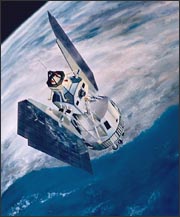Menu
Landsat 2 was launched on January 22, 1975, two and a half years after Landsat 1. The second Landsat was still considered an experimental project and was operated by NASA.
Landsat 2 carried the same sensors as its predecessor: the Return Beam Vidicon (RBV) and the Multispectral Scanner System (MSS).
On February 25, 1982 after seven years of service, Landsat 2 was removed from operations due to yaw control problems; it was offically decommissioned on July 27, 1983.

Quick Facts
- Launch Date: January 22, 1975
- Status: removed from operational status: February 5, 1982; decommissioned: July 27, 1983
- Sensors: RBV, MSS
- Altitude: nominally 900 km
- Inclination: 99.2°
- Orbit: polar, sun-synchronous
- Equatorial Crossing Time: nominally 9:42 AM mean local time (descending node)
- Period of Revolution: 103 minutes; ~14 orbits/day
- Repeat Coverage: 18 days


